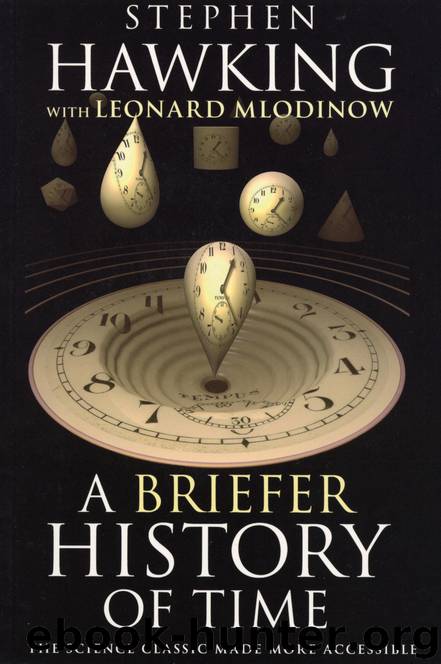A Briefer History of Time by Leonard Mlodinow

Author:Leonard Mlodinow
Language: eng
Format: epub
ISBN: 9781407066790
Publisher: Transworld
Faintest Possible Light
Faint light means fewer photons. The faintest possible light of any colour is the light
carried by a single photon.
The uncertainty principle tells us that, contrary to Laplace’s belief, nature does impose limits on our ability to predict the future using scientific law. This is because, in order to predict the future position and velocity of a particle, one has to be able to measure its initial state—that is, its present position and its velocity—accurately. The obvious way to do this is to shine light on the particle. Some of the waves of light will be scattered by the particle. These can be detected by the observer and will indicate the particle’s position. However, light of a given wavelength has only limited sensitivity: you will not be able to determine the position of the particle more accurately than the distance between the wave crests of the light. Thus, in order to measure the position of the particle precisely, it is necessary to use light of a short wavelength, that is, of a high frequency. By Planck’s quantum hypothesis, though, you cannot use an arbitrarily small amount of light: you have to use at least one quantum, whose energy is higher at higher frequencies. Thus, the more accurately you wish to measure the position of a particle, the more energetic the quantum of light you must shoot at it.
According to quantum theory, even one quantum of light will disturb the particle: it will change its velocity in a way that cannot be predicted. And the more energetic the quantum of light you use, the greater the likely disturbance. That means that for more precise measurements of position, when you will have to employ a more energetic quantum, the velocity of the particle will be disturbed by a larger amount. So the more accurately you try to measure the position of the particle, the less accurately you can measure its speed, and vice versa. Heisenberg showed that the uncertainty in the position of the particle times the uncertainty in its velocity times the mass of the particle can never be smaller than a certain fixed quantity. That means, for instance, if you halve the uncertainty in position, you must double the uncertainty in velocity, and vice versa. Nature forever constrains us to making this trade-off.
How bad is this trade-off? That depends on the numerical value of the “certain fixed quantity” we mentioned above. That quantity is known as Planck’s constant, and it is a very tiny number. Because Planck’s constant is so tiny, the effects of the trade-off, and of quantum theory in general, are, like the effects of relativity, not directly noticeable in our everyday lives. (Though quantum theory does affect our lives—as the basis of such fields as, say, modern electronics.) For example, if we pinpoint the position of a Ping-Pong ball with a mass of one gram to within one centimetre in any direction, then we can pinpoint its speed to an accuracy far greater than we would ever need to know.
Download
This site does not store any files on its server. We only index and link to content provided by other sites. Please contact the content providers to delete copyright contents if any and email us, we'll remove relevant links or contents immediately.
Tools of Titans by Timothy Ferriss(7803)
Turbulence by E. J. Noyes(7690)
Astrophysics for People in a Hurry by Neil DeGrasse Tyson(4997)
Secrets of Antigravity Propulsion: Tesla, UFOs, and Classified Aerospace Technology by Ph.D. Paul A. Laviolette(4974)
Design of Trajectory Optimization Approach for Space Maneuver Vehicle Skip Entry Problems by Runqi Chai & Al Savvaris & Antonios Tsourdos & Senchun Chai(4837)
Room 212 by Kate Stewart(4730)
Pale Blue Dot by Carl Sagan(4612)
The David Icke Guide to the Global Conspiracy (and how to end it) by David Icke(4376)
A Journey Through Divination and Astronomy by Publishing Pottermore(4245)
Apollo 8 by Jeffrey Kluger(3511)
Goodbye Paradise(3441)
Losing the Nobel Prize by Brian Keating(3424)
COSMOS by Carl Sagan(3346)
The Five People You Meet in Heaven by Mitch Albom(3333)
Brief Answers to the Big Questions by Stephen Hawking(3239)
How to Read Water: Clues and Patterns from Puddles to the Sea (Natural Navigation) by Tristan Gooley(3236)
How to Read Nature by Tristan Gooley(3073)
The Order of Time by Carlo Rovelli(3072)
A Brief History of Time by Stephen Hawking(2819)
